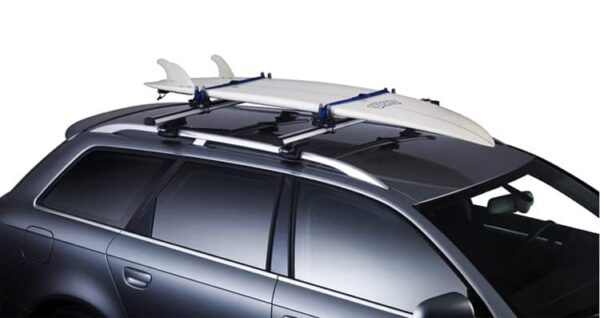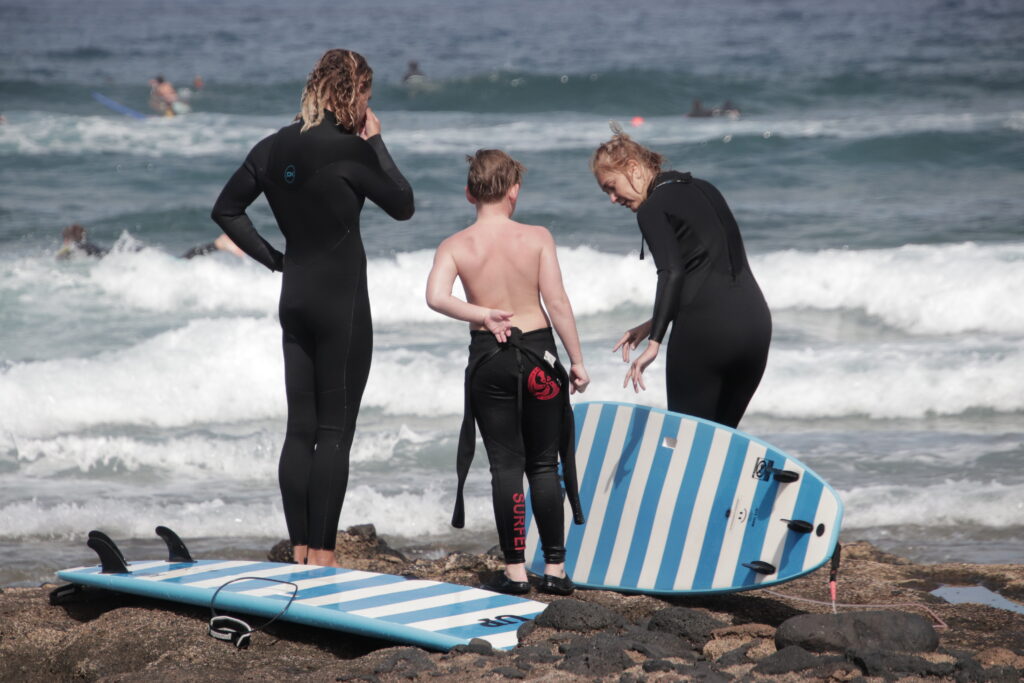How to Transport your surfboard in the Car? Guide, Legal and Safe 2025

Indice
You’ve planned the surf trip perfect. You’ve picked your destination, located in the beaches with waves magic, booked accommodation and you’ve got the car ready to devour miles. Bring all your team: the neoprene, the paraffin, the invention… but lack what is most important, your faithful companion: the surfboard. And here comes the big question that every surfer has become: how do I bring in the car in a lawful manner and, above all, safe?
Carrying a surf board may seem simple, but to do it wrong not only puts at risk your precious material, but also can result in fines of up to€ 200 and, what is worse, cause an accident. The Spanish law is very clear on the subject, and road safety is non-negotiable.
In this definitive guide, we’ll break down everything you need to know. From what it says in the rules to the different types of racks that are there, going through the step by step method to tie up your tables like a professional. If you want that your only concern is to choose the best wave, keep reading.
How can you bring the surfboard in the interior of the vehicle?
We start by resolving the doubt more often. Put the table inside of the car, lowering the passenger seat, is a practice extended by his apparent comfort and speed. However, we must be crisp: to transport a surfboard on the inside of the cabin is prohibited in Spain.
The regulations, in particular to article 14.1 of the General Regulation of Circulation, is very specific. Punishes “circular with the vehicle reviewed in whose charge can drag, drop, move in a dangerous or compromising the stability of the vehicle.” A surf board loose or improperly fastened in the inside is exactly that.
Beyond the fine of £ 200, the risks are enormous:
Danger in the event of an accident: In a collision or a sudden stop, the table becomes a projectile of high weight, and with sharp edges that can cause serious injury to the occupants.
Obstacle to driving: you Can move and hinder the use of the shift lever, the hand brake or even interfere with the movements of the driver.
Visibility reduction: misplaced, you can lock the view through the rear-view mirrors or windows.
Therefore, even if you see people doing it, the only way to correct, safe and legal is to take it out of the cockpit.
What is the legal way to transport a surfboard?
The answer is simple and direct: the surf board to be transported on the roof of the car, using a system of proper retention, commonly known as baca. This system ensures that the load is fixed, it does not compromise the stability of the vehicle and does not overhang the dimensions allowed by the law.
Fortunately, the market offers solutions to suit all budgets and needs. It is not necessary to have a car-specific or perform a permanent installation. Below, we explore all types of racks and systems to find the one that best suits you.
 Types of racks and mounts for surfboards
Types of racks and mounts for surfboards
to Choose the right system is key. Will depend on if you use always the same car, if you travel often, your budget and how many tables you normally carry.
1. Baca Fixed (Hard Rack)
Is the most traditional and, for many, the most secure and robust. It consists in a cross-bars that are anchored permanently or semi-permanent to the rails of the roof of the car or to the anchor points that many vehicles bring with them from the factory.
Advantages: It offers a subject extremely robust and reliable, ideal for long journeys and high speeds. Enables you to transport several tables without problem.
Disadvantages: The initial installation can be more complex and costly. Slightly increases fuel consumption and the aerodynamic noise generated, even when you’re not wearing tables.
Pro tip: always Put protective foam padding on the bars. So, your table rests on a soft surface, protecting it from shock and vibration. If you have a cover, use it always for double protection.
2. Baca Soft (Soft Rack)
roof rack soft or soft racks are the perfect solution for the surfing nomad. Are feet are padded with webbing built-in that is placed directly on the roof of the car and will ensure passing the strap through the inside of the vehicle through a door frame.
Advantages: they Are universal (apply to almost any car), very easy to put on and remove in minutes, economic and stored in the trunk. They are ideal if you’re using rental cars or different vehicles. A lot of newbies who are taking their first class surf tenerife opt for this system to begin with.
Disadvantages: May generate some noise from the vibration of the straps at high speed. If it rains, the straps that go on the inside may leak a little water to the interior.
Security: Although they may seem less robust, if installed correctly, they are surprisingly safe and reliable for all type of journeys.
3. Baca Magnetic
evolution of the racks soft. Use powerful magnets combined with webbing for attachment to the metal roof of the car. They are a very modern and practical.
Advantages: Installing and uninstalling snapshot. Does not require moving straps for the interior of the car, avoiding possible leaks or discomfort.
Disadvantages: Only work in metal ceilings (not valid for ceilings, fibre glass, carbon or panoramic glass). The ceiling must be perfectly clean for optimum adhesion.
4. System Lockrack
This is the most innovative and comfortable, designed for those who are looking for speed and maximum safety. Instead of webbing, use a padded arms that are adjusted to the extent of the table and the “embrace”, by locking in your site.
Advantages: Loading and unloading the table in seconds, without the hassle of straps. The majority of models includes a lock with a key, which allows you to leave the table in the car with total peace of mind, avoiding theft.
Disadvantages: it Is the most expensive option on the market.
5. Luggage rack (Hood or Trunk of a Roof)
If you’re looking for maximum protection, this is your option. A roof rack is a chest aerodynamic that is installed on a roof-rack and fixed in the interior of which you can save your tables and other material.
Advantages: Protects tables at 100% from the sun, rain, dirt and, above all, of the theft. It is perfect for long-distance travel or to leave the material in the car for days.
Disadvantages: this Is the most bulky and expensive. Significantly increases the fuel consumption and the height of the vehicle (be careful with the garages). You need space to store it when not in use.
How to Place and Tie up the Surf Boards on the Roof rack Properly
Have the best roof rack is of no use if you don’t know how to use it. Place and tie the tables is an art that every good surf school tenerife taught as a fundamental part of the culture of surfing. Follow these steps to do it like a professional:
Put the Protectors: If you use a roof rack fixed, always put the protective foam on the bars. If you do not have a roof (emergency method for short distances), use a thick towel to protect the roof and prevent the table from slipping.
The Tables Upside Down: The tables are always placed on the roof with the part of the wax down and the keels pointing up. This creates a support surface more stable and aerodynamic.
The Largest, Beneath: If you have multiple tables, apílalas always the larger and heavier (longboarders) to the smallest and lightest (shortboards).
Orientation of the Table: it is best to place the table with the bottom towards the front of the car (in the opposite direction to the motion). The curve of the hill (rocker) of the table will act against the wind, pushing the table down and against the roof, increasing the security.
Use Straps Quality: you Need at least two tie-down straps. The accessory key to tie the tables is called webbing, and consists of a nylon strap and a metal buckle of pressure that does not slip. ¡Never use octopus or bungee cords! Do not provide the necessary voltage.
The Tied Right:
Passes a cinch above the tables in the front bar and the other at the rear.
Spear the tip of the strap under the bar, roof rack and clear on the other side.
Introduce the tip into the buckle and tense with force. The belt should be flat, without twists.
Repeat the process with the other strap.
Ensures the Excess: The piece of webbing left over, it can’t be loose, because that befell the body and could unravel. Tie it to your own roof, or be sure to secure the door, metiéndolo inside and closing it.
The Final Test: once bound all over, grabs the tables for the tip and move them with the force laterally. The tables and the roof rack must be moved in solidarity with the car, as a single piece. If there are any game, re-tighten the straps.
What if I don’t have a luggage rack? How to tie a table without baca
Although it is not ideal and should only be done for very short journeys and at low speeds, it is possible to bind a table to a car without a roof rack.
Put a towel or foam in the center of the ceiling.
Put the table over (bottom facing up).
Open all the doors of the car.
Pass the straps over the table and through the passenger compartment of the car (through the gap of the doors).
Tightens the straps from the inside. Make sure that do not disturb the driver.
This method is less secure and not recommended for highway or long road trips.
The surf is a global experience, and places like Tenerife attract people from all over the world. therefore, the surf school tenerife are an investment in the enjoyment and safety.
 Types of racks and mounts for surfboards
Types of racks and mounts for surfboards